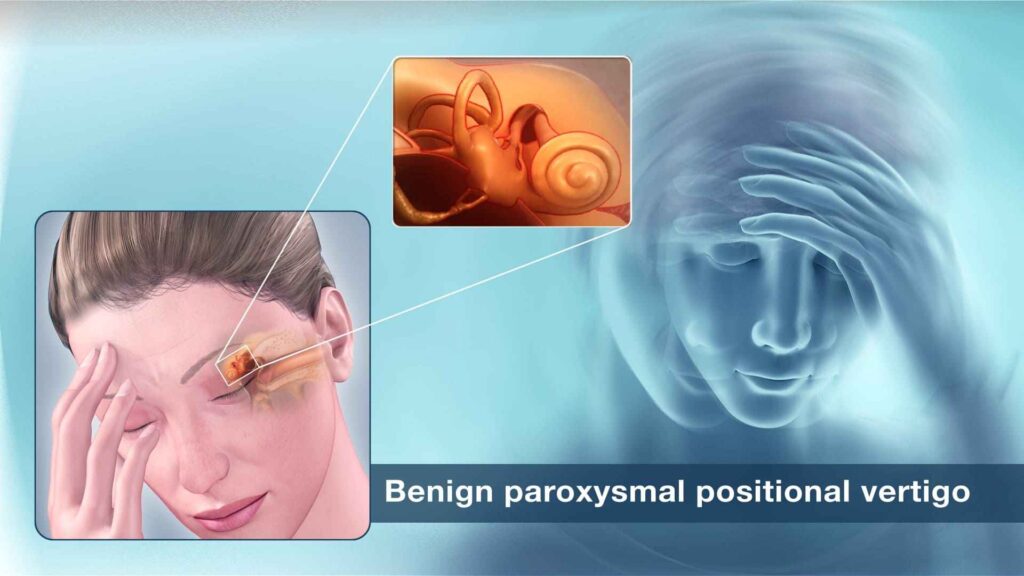WHAT IS BENIGN PAROXYSMAL POSITIONAL VERTIGO?
Benign paroxysmal positional vertigo (BPPV) is one of the most frequent causes of vertigo — the sudden sensation that you are spinning or that the inside of your head is spinning.
BPPV causes brief episodes of light to intense dizziness. It is generally triggered by specific changes in your head’s position. This may occur when you tip your head up or down, when you lie down, or when you turn over or sit up in bed.
Although BPPV could be bothersome, it is rarely severe except when it increases the chance of falls. You could receive effective treatment for BPPV during a doctor’s office visit.
SYMPTOMS
The signs and symptoms of benign paroxysmal positional vertigo (BPPV) can include :
- Dizziness
- A sensation that you or your surroundings are spinning or moving (vertigo)
- A loss of balance or unsteadiness
- Nausea
- Vomiting
The signs and symptoms of BPPV could come and go and commonly last less than one minute. Episodes of BPPV could disappear for some time and then recur.
Activities that bring about the signs and symptoms of BPPV could vary from person to person but are almost always brought on by a change in head position. A few people also feel out of balance when standing or walking.
Abnormal rhythmic eye movements generally accompany the symptoms of benign paroxysmal positional vertigo.
WHEN SHOULD YOU SEE A DOCTOR?
Generally, consult your doctor if you experience any recurrent, sudden, severe, or prolonged and unexplained dizziness or vertigo.
Seek emergency care
Although it is uncommon for the dizziness to signal a severe illness, see your doctor immediately if you experience dizziness or vertigo along with any of the following :
- A new, different, or severe headache
- A fever
- Double vision or loss of vision
- Hearing loss
- Trouble speaking
- Leg or arm weakness
- Loss of consciousness
- Falling or difficulty walking
- Numbness or tingling
The signs and symptoms listed above may signal a more severe problem.
CAUSES
Often, there is no known cause for BPPV. This is known as idiopathic BPPV.
When there is a known cause, BPPV is often related to a minor to a severe blow to your head. Less common causes of BPPV include disorders that damage your inner ear or, rarely, damage that happens during ear surgery or long periods positioned on your back, such as in a dentist’s chair. BPPV also has been related to migraines.
The ear’s role
Inside your ear is a tiny organ known as the vestibular labyrinth. It includes three loop-shaped structures (semi-circular canals) that consist of fluid and fine, hairlike sensors that monitor your head’s rotation.
Other structures (otolith organs) in your ear monitor your head’s movements — up and down, right and left, back and forth — and your head’s position associated with gravity. These otolith organs consist of crystals that make you sensitive to gravity.
For many reasons, these crystals could become dislodged. When they become dislodged, they can move into one of the semi-circular canals — particularly while you are lying down. This causes the semi-circular canal to become sensitive to head position changes that it would normally not respond to, which is what makes you feel dizzy.
RISK FACTORS
Benign paroxysmal positional vertigo happens most often in people aged 50 and older but can occur at any age. BPPV is also more frequent in women than in men. A head injury or any other disorder of the balance organs of your ear may make you more vulnerable to BPPV.
COMPLICATIONS
Although BPPV is uncomfortable, it hardly causes complications. The dizziness of BPPV could make you unsteady, which may put you at greater risk of falling.
DIAGNOSIS
Your doctor might do a series of tests to determine the cause of your dizziness. During a physical examination, your doctor will probably look for :
- Signs and symptoms of dizziness that are caused by an eye or head movements and then decrease in less than one minute
- Dizziness with specific eye movements that occur when you lie down on your back with your head turned to one side and tipped slightly over the edge of the examination bed
- Involuntary movements of your eyes from sideways
- Inability to control your eye movements
If your doctor cannot find the cause of your signs and symptoms, he or she may order additional testing, such as :
- Electronystagmography (ENG) or videonystagmography (VNG) – The objective of these tests is to detect abnormal eye movement. ENG (which uses electrodes) or VNG (which uses small cameras) could help determine if dizziness is because of inner ear disease by measuring involuntary eye movements while your head is placed in different positions or if your balance organs are stimulated with water or air.
- Magnetic resonance imaging (MRI) – This test uses a magnetic field and radio waves to create cross-sectional pictures of your head and body. Your doctor can use these pictures to identify and diagnose a range of conditions. MRI might be performed to rule out other possible causes of vertigo.
TREATMENT
Benign paroxysmal positional vertigo might go away on its own within a few weeks or months. But, to help relieve BPPV sooner, your doctor, audiologist, or physical therapist might treat you with a series of movements known as the canalith repositioning procedure.
Canalith repositioning
Performed in your doctor’s office, the canalith repositioning procedure consists of various simple and slow maneuvers for positioning your head. The purpose is to move particles from the fluid-filled semi-circular canals of your inner ear into a tiny bag-like open area (vestibule) that houses one of the otolith organs in your ear, where these particles do not cause difficulty and are more easily resorbed.
Each position is held for about thirty seconds after any symptoms or abnormal eye movements stop. This procedure generally works after one or two treatments.
Your doctor will likely teach you how to perform the procedure on yourself so that you could do it at home if needed.
Surgical alternative
In rare situations when the canalith repositioning procedure does not work, your doctor might recommend a surgical procedure. In this procedure, a bone plug is used to block the part of your inner ear that is causing dizziness. The plug prevents the semi-circular canal of your ear from being able to respond to particle movements or head movements in general. The success rate for canal plugging surgery is about 90 percent.
If you or anyone you know is suffering from benign paroxysmal positional vertigo, our expert providers at Specialty Care Clinics will take care of your health and help you recover.
Call 469-545-9983 to book a telehealth appointment for an at-home check-up.




